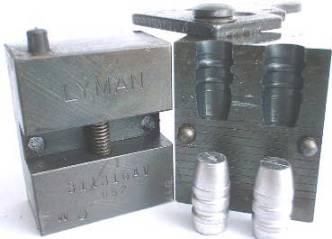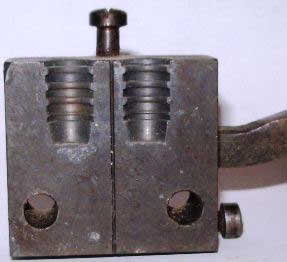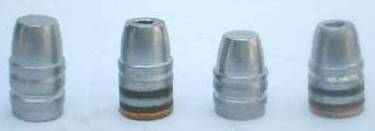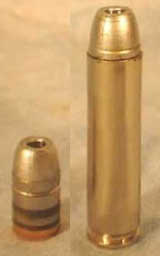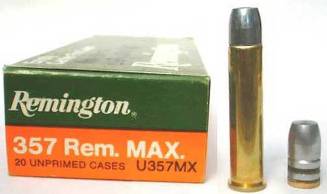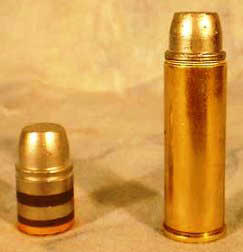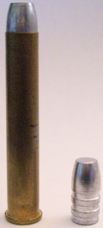|
|
|||||||||||||||||||||||||||||||||
|
Chapter 10 |
|||||||||||||||||||||||||||||||||
|
GC vs. PB Bullets: or "PB, or not PB, that is the question...." |
|||||||||||||||||||||||||||||||||
|
"Whether 'tis nobler in the mind to suffer the slings and arrows from the phantoms of leading, or to take arms against a sea of troubles, and by gas-checking end them…" (with apologies to both Hamlet and The Bard, I just couldn't help myself) Stop me if you've heard this one before -- a handgunner walks into your neighborhood gun shop and says, "I'd like to start casting my own bullets, but I'm a bit confused about all the different choices that are out there. I don't have a lot of money to get started with and I don't want to buy moulds that aren't going to work well for me in the long run. Should I buy a gas-check (GC) mould design, or would plain-base (PB) work better? Are GC's expensive, or hard to find, or hard to put on? I read all this stuff about cast bullets, leading and bad accuracy, and I'm confused. Which bullet design is better?" Yeah, I thought you'd heard it before. Well, what do we tell our budding young bullet caster? Let's look at why GC's were invented so we can gain some insight as to their best use. In August of 1902, Dr. Franklin Mann tested a new bullet for his .32 caliber muzzle loading rifle made by none other than Pope (described in his landmark treatise The Bullet's Flight from Powder to Target). These bullets were hollow-based and cast in a Zischang mould. They had a cavity on the base that was made to accept a brass machine screw, swaged into place in the cavity. The head is approximately bullet diameter. Dr. Mann's goal here was to create the perfect bullet base by preventing its distortion during the loading and firing process. These bullets were found to deliver approximately 1.5 MOA accuracy from the muzzle-loader. The ammunition was experimental and was created by custom, experimental loading tools and methods. Clearly, the concept of protecting a cast bullet's base with a harder, more durable metal was clearly taking form. The gas-check proper was patented by John Barlow in 1906, and subsequently described later that year in his Ideal Handbook #17. The year this took place is particularly relevant. Many of the rifle shooters of the day had learned about shooting cast bullets in rifles like the .44-40, .40-82, .45-70 and .38-55, but ballistically speaking a new day was dawning at the turn of the century. The .30-30 Winchester and the .30 US Army (a.k.a. ".30-40 Krag") was less than a decade old, and was harbingers of things to come. The fact that shooters were getting more interested in skinnier bullets, higher pressures and more velocity was not lost on John Barlow. The older cartridges shot PB bullets just fine with full-throttle loads. The .30-30 and .30-40 Krag could be made to shoot PB bullets acceptably well at somewhat reduced pressures and velocities, Barlow realized that the new cartridge that the US Government adopted in 1903 (the short-lived .30-'03) would leave shooters wanting more than was realistically achievable from a standard PB bullet. He set about to design a cast bullet that would allow higher performance from the newer, higher pressure .30 caliber rounds. He refined his ideas during the same year that the Army refined theirs, 1906. It is fitting that the GC was unveiled in the same year that that .30-'06 was; this was neither coincidence nor accident. It is clear that the GC was well-received by rifle shooters of the day as a variety of other GC cast bullet designs were introduced over the next several years, both in .30 caliber and various other rifle calibers (e.g. 7mm, 8mm, .35, and .375). Handgun shooters of that era by and large operated in a pressure/velocity regime served perfectly well by PB cast bullets, so GC handgun designs generated little interest in pre-WW I America. The exception was the 311316 GC .32-20 bullet. Although it was designed for high velocity rifle loads, it could be fired from both rifles and revolvers. Elmer Keith mentions GC bullets only in passing in his 1936 Sixgun Cartridges and Loads (on page 86), specifically addressing their use in high velocity loads in the .32-20 Colt Single Action Army (and similar loads for the .44-40, using the Ideal 429434 221 grain GC-RNFP). This is one of the few instances where he had anything good to say about GC's in revolvers. Hold that thought, we'll return to it a little later.
The introduction of the .357 Magnum in 1935 would change the landscape of handgunning. It introduced high-pressure, high-velocity loads to the mainstream revolver shooter. Factory .357 Magnum ammo was loaded with soft, swaged lead bullets, and lubed with some flavor of marginal mystery grease. Leading was reported to be hideous. As a result the .357 Magnum quickly developed a reputation for insidiously problematic leading, and that reputation scared people into thinking they should probably have GC's on bullets they cast at home for their .357 Magnums, or suffer a similar fate. It is important to realize that the bullets used by Phil Sharpe in the development of the .357 Magnum, as well as those used by Elmer Keith in his .38/44 load development, were virtually all PB bullets, and both of these expert handgunners obtained excellent results with them (see for example, the groups published in Sharpe's Complete Guide to Handloading). Indeed, the Ideal Handbook #34 (published in 1940) lists the PB Ideal 358446 as "the Standard Bullet for the .357 Magnum". Sharpe and Keith cast their .357 bullets with a BHN of 10-12, used quality bullet lubes, and had no problems with leading. The same is true today. But, the seeds of suspicion had been planted...
So, when did the first GC cast bullet designed specifically for a handgun come out? Cramer listed two GC handgun designs (#13 and #14) for the .357 Magnum in their 1939 catalog. These bullets are very similar to the 358156 HP/SWC, except with a somewhat shorter nose, and were designed by Ross Sernow of Los Angeles, CA. They were reported to perform equally well in the .38 Special and "the Magnum", and to be especially well adapted to hunting. It seems clear that these bullets were designed to prevent leading in high-performance field loads in the .357 Magnum. However, several of Cramer's other PB designs were listed identified as being specifically for "the Magnum", so Cramer recognized that a GC was not necessary in the .357.
Ideal Handbook #37 published in 1950 showed most of their rifle bullet designs as being gas checked. However, none of their handgun bullet designs were gas checked at that time. GC cast bullet designs specifically for handguns did not appear until about 1953 when Ray Thompson’s GC handgun designs were cataloged in the Lyman-Ideal Handbook #39. In that issue was cataloged for the first time the Thompson GC under #358156 and recommended for the .357 Magnum. This same issue also listed Thompson’s two .44 SWC-GC designs as #431215 and #431244. It is
interesting to note that Lyman apparently reused some of their cherry numbers. For instance, the design originally carrying cherry #156 was actually #308156. It was used in the .32-40 Remington which was designed as a mid-range match cartridge for use in Remington’s single shot target rifles. Remington designed it as .32 caliber, but in fact, it was actually .308-.309 caliber. The cherry originally carrying #215 (429215) was a 205 gr. RN designed by Anderton for use in the .44 S&W Russian. The cherry originally assigned #244 (308244) was an 89 gr. RN for use in the .30 Luger. Ideal Handbook #39 only listed loading data for the 358156 (both SWC and HP) in both the .357 Magnum and .38 Special. No other GC bullets were listed in the handgun loading data even though the .32-20 and the .44-40 have GC bullets listed in the rifle section of the loading data. Several new GC handgun designs were listed at the end of the loading section in Ideal Handbook #40 (1955) as New Bullet Designs available from Lyman. These designs included the 452484, a 225 grain GC-RN for the .45 ACP; the 452490, the 230 grain Thompson GC-SWC for the .45 Colt; and the 454485, a 250 grain GC-RNFP also for the .45 Colt, derived from the old 454190. The gas-checked cast bullet was clearly gaining acceptance amongst handgunners. In terms of their long-standing record of outstanding performance, the Thompson GC-SWC designs rank right along side the Keith SWC's; they are truly excellent bullets. A GC allows one to shoot a somewhat softer bullet without leading, and this can be useful for getting cast bullets to expand at revolver velocities, and such was the motivation behind one of the more creative variations on the GC theme that's been tried. Introduced in 1953 (Ideal Handbook #39), and described in detail in Handbook of Cast Bullets (1958), were a series of moulds designed and developed by Jim Harvey that allowed the caster to insert a zinc (Zn) washer into the mould cavity and cast the bullet metal through a hole in the center of the washer, permanently joining the two when the bullet metal solidified. The bullets were ready to shoot as-cast, with no sizing or lubrication. Harvey's motivation for designing these bullets was to be able to shoot very soft pure lead bullets that would expand while hunting, without leading problems. These moulds were marketed under the "Harvey Prot-X-Bore" name and were made by Lyman. The mould numbers were in the 500 series, which Lyman had set aside for their experimental designs. The most commonly encountered of these moulds today is the 358500 SWC for the .38 Special; note that this bullet had no provision for crimping or lubrication. The .44 Harvey SWC's, the 220 grain 429508, 170 grain 429509 and the 245 grain 429518, as well as the .45 Harvey SWC's 190 grain 452505 and the 454506 also lacked lube and crimp grooves. Interestingly, the .357" diameter 119 grain SWC (Lyman 358502) had a crimp groove and the Harvey 125 grain wadcutter (Lyman 358503) not only had a crimp groove, but 2 lube grooves as well. The absence of these features on the later, larger caliber Harvey designs indicates that Harvey felt they were not needed. In fact, wildly exaggerated claims were made about the "dry lubricating" ability of the zinc washer. The Handbook of Cast Bullets (an excellent reference published by Lyman in 1958) has a section on Jim Harvey and his bullets, and in it they admonish the shooter to seat and crimp his bullets in separate operations, as crimping during the seating step can distort the shoulder to the point of preventing the loaded round from chambering. The absence of a crimp groove means that the crimping operation must displace bullet metal and if this happens while the bullet is still going into the case a bulge is formed. The loading data for the Harvey Prot-X Bore bullets suggests that these lightweight bullets are capable of exceptional velocities in the 1600-1900 fps range. Although their accuracy at these speeds has been criticized by multiple sources, at modest velocity they seem to shoot fairly well.
Back in 1990, in the first Handloaders Bullet Making Annual, Dave Scovill reported on the perforated GC developed by Edmund Wilk. The basic idea was to remove the center of a normal GC, and cast the bullet through the center, much like the Harvey Prot-X-Bore concept. The difference is that the bullet still needs lubrication and the GC can be placed on any of the driving bands of the mould, aimed at accomplishing different tasks. For example, Scovill found that placing the GC on the forward driving band of the Keith 454424 eliminated skidding on this band during engraving, whereas he reports evidence of skidding of the original SWC's that he cast. In other loads he found that the Wilk GC reduced or eliminated leading. In general, Scovill found that good loads were not improved upon, or surpassed, by bullets fitted with the Wilk GC, but that the accuracy of marginal loads was generally improved. Now that we've seen where the GC came from, why they were invented, and some of the variations on the GC theme that have been toyed with, let's get back to our gunshop novice and his concerns. A very common misconception is that if you drive a PB cast bullet faster than about 1000 fps, horrendous leading will result, and the sixgunner won't be able to hit a barn from the inside. This just flat ain't true, folks! This "old-wives tale" is simply a hold-over from the reputation that the original .357 Magnum factory ammo had for leading (and remember, that was due to extremely soft bullets and poor lube quality). PB bullets can be driven considerably faster than 1000 fps with no leading whatsoever, all day long. Leading is a complex issue, and one that is addressed in a separate chapter. But, in a nutshell, the primary variables involved in leading and its prevention are alloy hardness and obturation, matching bullet diameter to throat/groove diameter, lubricant quality and quantity, powder selection and bore condition. Note the distinct lack of any mention of the presence or absence of that cute little copper diaper that we call a GC. For routine revolver shooting up to about 1500 fps, PB bullets can shoot just as cleanly and accurately as a GC bullet. They can at even faster speeds, but that requires that the shooter pay a little closer attention to a few very specific details. As always, the new bullet caster wants to know, "Which bullet is better?" Well, this requires that we ask the budding young caster-to-be what criteria are being applied to determine "better"? Usually, the answer is "Accuracy". Oh yeah, and he wants to avoid that mystical triple-horned demon of the netherworld, "leading". We've already touched on the issue of leading so let's focus on accuracy - which cast bullet design (GC or PB) is inherently more accurate? I'm going to let you in on a little secret here, known only to grizzled old alchemists, gun-hacks and other ne‘er do wells. Lean over close so I can whisper, neither design is inherently more accurate than the other. Shhhh, don't tell.... When we think of cast bullet accuracy in revolvers, what is the most universal benchmark you can think of? My vote is for the classic .38 wadcutter target load. Have you ever seen a GC on a .38 wadcutter? Believe it or not, moulds have been made for GC wadcutters (and Terry Murbach tells me that these moulds were offered by more than one maker). Bottom line? This is an experiment that has been tried several times over the years, and it just didn't bear fruit. You never see them around because the results are simply not worth the effort. You can be sure that if the GC improved accuracy, bullseye shooters would burn them by the bucket-load. The take-home lesson here is that a GC does not make a cast bullet inherently more accurate. Inherent accuracy is more an issue of cast bullet quality, the care with which the ammo was assembled and the inherent "tastes" of a particular sixgun, than it is a question of whether or not the cast bullet is wearing a GC on its backside. To quote my respected friend John Taffin, "Every sixgun is a law unto itself." As an example, I have a S&W 657 Classic Hunter .41 Magnum that is delightfully accurate with the plain-based Hensley & Gibbs #258 Keith SWC at full-throttle, and likewise does very well with most other PB bullets, like the RCBS 210 SWC. Feeding that gun cartridges loaded with GC SWC's will make groups open up considerably to the point of looking more like buckshot patterns. Why? I don’t know. It just does. As a counterpoint, I have a stainless 4 5/8" Ruger Super Blackhawk .44 Magnum that is just plain mediocre with pretty much everything loaded with PB bullets, with groups generally running in the 2 1/2" range at 25 yards. Nothing great, nothing horrible, just, well, boring. But, feed that gun the Lyman 429244 GC-SWC, or its hollow-pointed kid brother, and groups become one ragged hole. Some guns like PB bullets, some guns like GC bullets, some guns like 'em both, but neither bullet design is inherently more accurate than the other overall. That was about the level of my understanding of bullet casting operations back in the early days of my casting career -- just get a bunch of different moulds, cast a bunch of different kinds of bullets, shoot them all and see what cartridge does well with which bullet(s). Then I read Veral Smith's handbook ("Jacketed Performance from Cast" available from LBT). Among the numerous pearls of wisdom scattered therein is the observation that a GC becomes critical when a cast bullet load combines high velocity and high pressure (Veral was primarily addressing rifle loads here, but his conclusions are equally valid for revolvers). It's not just a question of velocity, or of pressure, but rather the combination of the two. Suddenly the clouds parted, the sunbeams came streaming through, the angelic choirs sprang into song and a small dose of enlightenment was bestowed upon this humble caster. Now, all of my scattered, independent observations started forming "The Big Picture"! A lead alloy bullet could handle things just fine up to a point, but beyond a certain pressure and velocity it needed that little copper crutch to perform its best. For example, the LBT .358-200 grain LFN plain-based bullet loaded to about 1500 fps in a Ruger .357 Maximum resulted in severe leading and horrid accuracy. In contrast, the same bullets cast of the same alloy, loaded to similar pressures in the .357 Magnum at about 1200 fps were very accurate and clean-shooting (and in fact, is one of my favorite long-range plinking loads). The combination of roughly 35,000 psi and 1500 fps velocity resulted in leading, but 35,000 psi and 1200 fps didn't. Shooters generally tend to first think in terms of velocity when addressing the PB/GC dichotomy. This is because we, as shooters, are obsessed with velocity. We pour over ballistics tables and reloading manuals, we chronograph load after load, we tailor loads for specific power levels based on velocity, and we create new cartridges in the pursuit of more (e.g. .44 Magnum), or less (e.g. .40 S&W) velocity. After all, it's velocity that allows bullets to do their job, and then dictates how well they do it. A bullet at 1000 fps is a lot more useful and interesting than the same bullet sitting on your desk next to your laptop. But leading is not simply the result of velocity. Look, for example, at the cast bullet loads for the .45-70. It's no trick at all to put together the low-pressure PB .45-70 loads at 1600-1700 fps that shoot very cleanly. Nor is leading simply the result of pressure. The SSK 350 grain FP can be shot at 1400 fps from a Freedom Arms 454 Casull with 26.0 grains of H110. Accuracy is very good and leading is not an issue, in spite of the fact that this is a 40,000+ psi load. No, a sixgunner's cast bullet problems arise when one combines high velocity with high pressure, and that is precisely where the gas-check earns its keep. What does a GC do? Quite a bit! But perhaps the most important is that it helps to seal the bullet's base to minimize gas leakage. This can also be accomplished with a PB bullet through the appropriate choice of alloy for the load, allowing plastic deformation (obturation) of the bullet so it can seal the bore. Factored in to all of this (and commonly overlooked) is the fact that bullet lube serves as a floating, fluid gasket that follows the bullet down the bore, also helping to seal the system. It has been recognized for many years that the flow characteristic of bullet lube is one of its most important properties. So with the right alloy and a good lube, we don't need a GC to seal the system for run-of-the-mill sixgun loads. But both of these sealing mechanisms can be overwhelmed at some point. Increased velocity results in increased abrasion defects along the engraved face of the bullet following the trailing edge of the lands. At high pressures, gas can and does, leak through these velocity induced defects. For the sixgunner, where do pressure and velocity both rise to the point of making a GC important? Well, it depends on the alloy hardness, lube viscosity, etc.. Perhaps this starts to happen at the magnum revolver pressure/velocity level? Remember the horrible leading and accuracy that was obtained with the original .357 Magnum lead bullet loads? Please, recall that those were swaged lead bullets and therefore extremely soft, and the lube was marginal at best, thereby offering a clear demonstration of how these sealing mechanisms can be overwhelmed when substandard materials are used. Cast of a suitable alloy, e.g. BHN >11, PB bullets work just fine in all of the Magnum revolvers. These guns generally operate around 35,000 psi peak pressure, with velocities in the 1300-1400 fps range. With good alloys and good lubricants, PB bullets work just fine at this level. When we start to ratchet pressure and velocity much beyond this level, a PB bullet can run into some serious problems. What does this mean for the sixgunner? Well, there are 3 factory cartridges that make me think of GC bullets as a "knee-jerk" first choice for standard weight bullets - the .30 Carbine, the .357 Maximum, and the .454 Casull. These are sixguns that routinely operate at pressures above 40,000 psi, and their bullets generally leave a revolver barrel in excess of 1500 fps. Now I'm not trying to say that PB bullets can't be made to shoot well out of these guns (they can), but rather when these cartridges are run at their normal, full-throttle level, they can make life very hard on
a PB bullet. As an example, one of the loads my OM .30 Carbine Blackhawk just dotes on is 13.0 grains of W296 underneath the plain-based Lyman/Ideal 311008 HP (112 grains) for 1440 fps. This is not a maximum load pressure-wise (I would guess that it's only about 25,000 psi peak pressure), but it's about the limit of what I can squeeze out of this particular PB bullet before running into leading and accuracy problems. Don't get me wrong, this is an outstanding varmint load, it's just not loaded to the full potential of the cartridge and gun. To run the peak pressures up to the 40,000+ psi range and velocities up to almost 1600 fps in this gun, I like to use the Lyman 311316 GC-SWC-hollow point cast of WW alloy with 2% added tin, air-cooled weight is 109 grains checked and lubed. 13.0 grains of Accurate Arms #9 give very good accuracy in the .30 Carbine Blackhawk, and generate 1570 fps. No two ways about it, this is a high performance varmint load!
The .357 Maximum is a kind of "red-headed step-child" of the cartridge world; it's gotten beat up for all kinds of things that weren't really its fault. The top-strap gas-cutting issues, forcing cone and barrel erosion problems can be mitigated through the proper choice of powder. My favorite loads are powered by 4227 and sparked by the CCI 450 primer. The .357 Maximum is a fine hunting round, and one that handles cast bullets just fine, but they had better have a GC on them if you're going to run this round at full-throttle. An excellent hunting bullet for the Maximum is the LBT 180 grain WFN-GC, cast with water quenched WW alloy and lubed with homemade molly lube. This bullet leaves very little room for clearance at the end of the Super Blackhawk cylinder. It must be fully seated and firmly crimped in place to avoid tying up the cylinder. Fortunately, the .357 Maximum doesn‘t have much recoil to jar this bullet loose. By putting as much of the bullet outside of the case as possible, it leaves significantly more case capacity than do other 180 grain bullets, which are generally seated much deeper. This helps to keep pressures down and allows the use of more powder for potentially higher velocities, than would be possible with other 180 grain bullets. For this bullet, I use 23.0 grains of 4227 and the CCI 450 primer for excellent accuracy and 1600 fps.
An excellent all-round choice for the .454 Casull is the RCBS 45-300-SWC-GC (312 grains checked and lubed). I had a 7 ½” Ruger Super Redhawk that was partial to this bullet over 30.0 grains of H110, sparked with a CCI 400 primer, which generates 1650 fps. I generally cast these bullets fairly hard (BHN of 18 or so) using WW alloy, sweetened with a little linotype, cast hot and water quenched as they drop from the blocks. This is a 50,000+ psi load that leaves the barrel spotless, and shoots pretty dog-gone well. Ruger didn’t make the same mistake with this gun that they made with some of their .45 Colt Blackhawks. There have been several Blackhawks with .484” chambers and .450” throats that have passed through this writer’s hands. The excellent accuracy that this 454 Super Redhawk delivers is likely due to the tighter chambers and properly-sized throats that Ruger used on this gun. Cases come out of the cylinder at .478” and the throats are a snug .452”. In short, this is a very well-made revolver. I’ve had mis-informed blow-hards vociferously preach at me that they never shot cast bullets, only jacketed bullets, because they wanted “magnum performance” from their revolvers. Well Friend, I’m here to tell you that a 310 grain Keith-style SWC at 1650 fps with pin-point accuracy qualifies as “magnum performance” in my book! One other place where a GC can make a real difference is in a ported or braked handgun. Here the difference between PB and GC depends on port pressure and how much base erosion takes place as the PB bullet crosses the port. As the bullet’s base crosses over the port, the escaping gases can cut the unsupported and exposed portion of the bullet’s base, creating small divots that can lead to instability when the bullet leaves the barrel and enters free flight. This was observed as far back as 1900 in Dr. Franklin Mann's ballistic research. The harder copper GC prevents this erosion, and leads to more stable bullet flight. I have never had a ported/braked barrel NOT shoot GC bullets well, while PB bullets have almost always given me poor accuracy in ported guns.
Presumably this could be countered by using some sort of felt or plastic wad or some such addition to protect the PB bullet’s base, but I haven’t tried this as a GC bullet gets me where I want to be quicker and easier. As an example of this, my .405 Winchester Contender is Magna-Ported, and PB bullets don't shoot worth beans out of this gun, but GC bullets like the Mountain Molds 300 grain GC-FP shoots exceptionally well over 55.0 grains of H4895 at 1900 fps. Is there a time where the GC is a detriment? No, but they do add significantly to the expense of the cast bullet, they add an extra step to the loading process, and they aren‘t always readily available at your friendly local gun-shop if your supply runs out a few hours before you leave for the state championship, or a hunting trip. A while back, I went on a tour of all the major gun-shops in my community looking for a box of .45 caliber gas checks, and on that afternoon I found a grand total of 4 boxes of 6mm GC's, period. Elmer Keith didn‘t like GCs for these reasons for his revolver loads, and I tend to share that opinion (although, I do keep a supply on hand). Why add something if it isn’t necessary? What‘s more, it almost seems sacrilege to load GC bullets into time-honored traditional (and relatively low pressure) cartridges like the .45 Colt, .38 Special .44 Special and .45 ACP. Loading a GC into one of these grand old rounds at 850 fps seems almost as silly as loading them with boat-tailed spitzer bullets. And while a GC is sometimes useful in higher pressure rounds, they just aren’t necessary in cartridges like .357, .41 and .44 Magnums; useful sometimes, necessary no. Annealing Gas Checks Gas checks as they come from the factory, can benefit from being annealed. The stamping and forming process work hardens the copper and gives it a springy nature. The gas check lip when compressed in the sizing die can spring back and lose it’s grip once it leaves the confinement of the die. Since the gas check is harder than the bullet alloy, it may not obturate as one with the bullet when the assembled unit (bullet) is fired. The annealing process requires the use of heat. Preferably, the checks should be taken to faint red heated and quenched in water. A steel container will need to be acquired to contain the loose checks while heating. A discarded open mouth can will work well as a container. The container can be heated with a propane or acetylene torch. Red heat will render the checks fully softened. Ideally, this will give the best results. However, if it is not feasible to bring the checks to full softness, the checks can be placed in a steel container that will sit on the melt of the lead pot. Your lead pot will generate sufficient heat to anneal the checks to a satisfactory level of softness. 750o is sufficient to provide good performance of the check. At this heat, the checks can be air cooled. Now, this is not ideal, but it will suffice until you can acquire or devise a better method of annealing to bring the checks down to dead soft. Occasionally a mould will be encountered that casts bullets with oversize gas check shanks. Needless to say, this is aggravating as it causes an extra step in the gas checking process. If you run into this condition with a mould, one solution is to expand the gas check enough so it can be pushed onto the bullet shank. This requires the use of a punch and a stripper so the expanded gas check can be removed from the punch. So, getting back to our gun shop casting novice, "Which bullet design is better?" Neither one. We can't tell you which one of your pet .44 Magnum is going to shoot best, only your revolver and a little range time can tell you that. We can tell you that both will probably shoot just fine (assuming the gun and shooter are up to the task). PB cast bullets are simpler, cheaper, faster to produce and offer a more traditional approach to the handgunners art than do GC bullets. If the shooter understands how to assemble quality cast bullet ammunition, and is using a lubricant and alloy that are suitable to the ballistics of the load, then a GC provides no advantage for the majority of revolver applications. What a GC buys the sixgunner is the ability to be a little sloppy in the selection of alloy, lube or powder and still achieve good results. As a result of this flexibility, it may be a little easier to find an accurate load with a GC cast bullet. PB designs will also shoot very well in most guns, and significantly better in some. A GC is not a cure-all, and mis-application of GCs will result in poor accuracy. Quality control, both in terms of casting technique and loading technique, is what's really important for both GC and PB bullets, period. For a new caster, the most important thing is to start with a bullet design that has a well-established track record for accuracy, and I can't think of a better place to start than the Keith SWC’s. If the new caster decides to go with GCs, then the SWC’s designed by Ray Thompson are similarly excellent bullets. Where GCs really become necessary is when the shooter combines high pressure (>40,000 psi) and high velocity (>1500 fps), or is shooting a ported gun. While there are any number of custom wildcat cartridges in this pressure/velocity regime, the more common factory sixgun cartridges that really benefit from the use of GC cast bullets are the .30 Carbine, the .357 Maximum and the .454 Casull. |
|||||||||||||||||||||||||||||||||
|
|
|||||||||||||||||||||||||||||||||
| Table of Contents | Continue to Chapter 11 - The Wadcutter | ||||||||||||||||||||||||||||||||
| Index of Additional Glen E. Fryxell Shooting Articles | |||||||||||||||||||||||||||||||||
